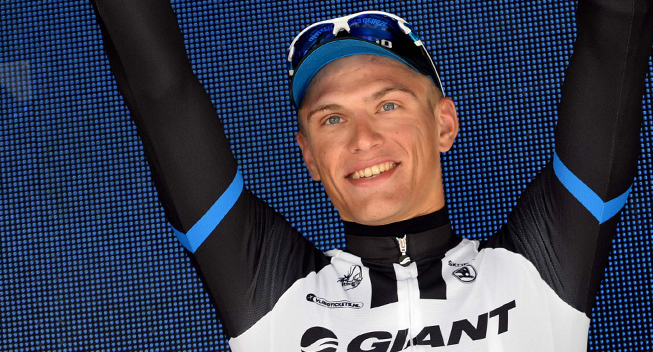Yesterday Team Giant-Shimano announced their 9-rider roster for the Tour de France and said that the team was composed of two different lead-out trains. The team has now detailed how they want to prepare the sprints for Marcel Kittel and John Degenkolb.
For the 2014 Tour de France, Team Giant-Shimano are focusing once again on sprinting success and the most opportunities lie in setting up a sprint finish for Marcel Kittel and John Degenkolb, the riders have two different sprint options – the pure sprints and the power sprints.
Pure sprints refers to the flat out very fast and flat sprints for Kittel, and the power sprints are the more endurance based sprints after a hard day in the saddle where the finish may be slightly uphill or after a late climb, and for these Degenkolb is more suited.
However having two different sprinters requires two different lead-outs. This led the Team Giant-Shimano coaches and experts to come up with two different sprint formations within a team of nine to be able to deliver each of the riders to the finish in the best position possible.
All positions are different with a dedicated training plan to get the maximum out of each rider in that position – from training on the road to power work int he gym, as well as lots of practicing in both training and racing.
The two line-ups have been defined as the Pure Sprint Formation, based around having Kittel as the final man in line; and the second is the Power Sprint Formation, where Degenkolb is the last rider through. The Pure Sprint Formation involved all nine riders in the Tour, while the Power Sprint Formation will generally see less riders in the latter stages meaning that there are fewer riders in the formation at the end of the stage.
Pure Formation
Sprinter: Marcel Kittel
Lead-out: Tom Veelers
Accelerator Pilot: John Degenkolb
Speed Pilot: Koen De Kort
Captain: Roy Curvers
Positioner: Albert Timmer
Positioner: Tom Dumoulin
Controller: Dries Devenyns
Controller: Cheng Ji
Power Formation
Sprinter: John Degenkolb
Lead-out: Koen De Kort
Accelerator Pilot: Tom Dumoulin
Speed Pilot: Albert Timmer
Speed Pilot: Dries Devenyns
Captain: Roy Curvers:
Controller: Cheng Ji
The Positions Explained
Sprinter
The most obvious of all the positions is the sprinter, the final man, the one who puts the final power down in each sprint in the final few hundred metres to the line. This position requires strength, a cool head and an eye for the tactics in the sprint as it is also up to the sprinter as to when the last men in the line move and jump once the Captain has pulled off.
Lead-out
The penultimate rider in the line is the one who has the sprinter nestled on his wheel, ready to pounce. It is this rider’s role to sprint from around 600m out to around 150 – 250m depending on the wind speed and direction. If there’s a headwind finish then the sprinter will stay on the wheel as long as possible where as if there’s a tailwind the sprint unfolds earlier and carries more speed. As such the lead-out man needs to have speed and power as well and is capable of finishing highly in bunch sprints on his own.
Accelerator Pilot
The accelerator pilot is the rider third from the back who when he comes to the front it is his role to do a stretched out sprint, increasing the pace from about one kilometre out until around 500m from the line at which point the lead-out man makes him move.
The accelerator pilot keeps the speed high enough to keep the formation in control but balanced enough that he can maintain this until when the lead-out man takes over.
Speed Pilot
The role of the Speed Pilot is to be the first major injection of pace into the formation within the final 1500m. The rider will usually take a 500m all-out pull from around 1500m to go until the flame rouge. This role is to keep the pace high at the front of the bunch, or if the formation is coming from behind then it is to bring the remaining riders through to the front.
Captain
The captain is in both circumstances Roy Curvers, the Team Giant-Shimano road captain at Le Tour. It is the Captain’s role to organise the team during the stage and to be aware of what is going on in the race at all times. This role requires experience.
Positioner
The positioners are the riders who bring the sprint formation through into position after, or just as the breakaway is being caught in the latter stages of the race. Their role involves a gradualy increase in pace and will see them at the head of the formation for between one and two kilometres each.
Controller
The role of the controller starts long before the sprint starts but it is the first step in setting up a sprint, and that is helping to take control of the stage and make sure that firstly the right breakaway goes away – one with the ideal number of riders, no more that five or six, and with no representatives of other sprint teams so that they also have to contribute to the work. The job of the controllers would typically see them letting a break go then setting a steady pace before gradually increasing the tempo once the gap has reached what the team deems its maximum for the parcours. Then they will start to pick up the pace and bring the riders back to set up the ensuing sprint.
| Juan Manuel SÁNCHEZ 34 years | today |
| Antonio GIORDANO 37 years | today |
| Alexander EDMONDSON 31 years | today |
| André KREMER 36 years | today |
| Sheng ZHONG 32 years | today |
© CyclingQuotes.com









